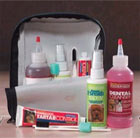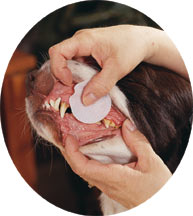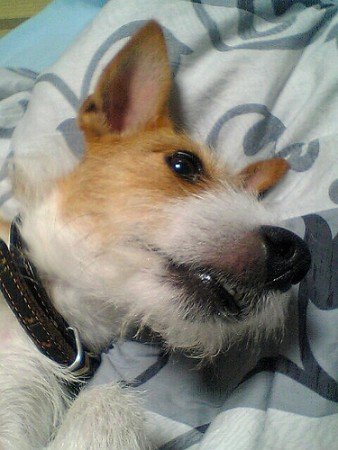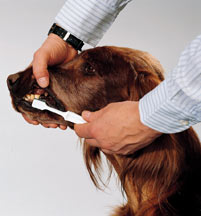
|
||
Instructions for Proper Dog Dental Care
A Step-by-Step Program From the Educational Staff of Drs. Foster & Smith Regular oral hygiene is a necessity for good dog dental care, but is often neglected or entirely overlooked by many owners. Even conscientious owners who arrange for annual, semi-annual, or more frequent cleanings by their veterinarian discover that this regimen will not prevent every problem. The reason is simple. Each time your dog eats, plaque forms around its teeth. In one to three days, the plaque hardens into tartar that irritates gums, and opens the door to painful and damaging diseases. Regular cleaning is needed to prevent tarter build-up
and dental problems. More serious problems can result in tooth loss, and even diseases affecting the entire body. In fact, teeth and gum problems are among the most commonly diagnosed in dogs over three years of age. By putting off home dog dental care now, you may learn a
difficult lesson later...preventive care is far less expensive than
remedial dog dental care. Home dental care is easy: Home dental care is neither expensive nor difficult. All you need are the right tools and the desire to succeed. Below we have provided a short list of quality items we know to be effective, and recommended steps to help you and your dog become accustomed to routine care. Dog dental care is an activity best learned in small
steps, repeated regularly - daily if possible - until your dog is ready
to move from one step to the next. During the training period, and
later during regular cleaning sessions, use a relaxing, upbeat tone of
voice. At the conclusion of each session, provide a treat. Your
attitude, and rewards, will make dog dental care an activity your dog
anticipates and enjoys.  Effective
dental
care tools: Effective
dental
care tools:To avoid delays in training, assemble all of the items you will need in advance. Drs. Foster and Smith offer a range of products for all sizes and types of dog. You'll find that their dog Dental Care System contains everything you need to get started. So let's look at the tools you'll need... Tartar Control Toothpaste to brush off that nasty and unsightly tartar that destroys teeth. Dental Cleanser Solution This stuff is easy-to-apply. Chlorhexidrine solution kills bacteria that lead to plaque and gum disease. It's truly great. Finger Toothbrushes Select this soft nylon toothbrush, designed especially for dogs, sized properly for your pet. Consider a finger toothbrush if your dog proves to be brush-fussy. Dental Treats and Toys - A selection of products are designed to provide dental benefits, including Dental Greenies a tasty, nutritious chew formulated to clean stubborn tarter and plaque off teeth. Homeopathic Support - Homeopathic natural products such as Gumz-n-Teeth and Oral Health Mouth Spray (also promotes fresh dog breath) can help to maintain health in gums and teeth. Can't recommend these products enough guys. Your Jack Russell's teeth will be the best on the block, not to mention some really nice breath. Home dog dental care cleaning...a step at a time: Some dogs will become accustomed to cleaning procedures almost immediately; others will require several days, or even weeks. Your pet will determine how fast you can move through the following recommended steps: Days 1-4: First, your dog needs to become comfortable with you working in its mouth. Hold your dog's muzzle with one hand and gently stroke the muzzle with the other. Then, slowly lift the upper lip, exposing the teeth. Do this for short intervals for a number of days. Days 5-8: Next, accustom your dog to
new tastes. Dip your finger in a beef broth, and allow your dog to lick
some from your finger, and then work it lightly over his teeth and
gums. Repeat this procedure for 15 to 30 seconds for 3-5 days, and then
substitute dental solution or toothpaste specially formulated for dogs.  Days 8-14:
Now, it's time to condition your dog to actual cleaning. Wrap your
finger in gauze, soak it in dental solution or paste, and gently rub
your dog's teeth in a circular motion. For this step, you can also use dental pads. Days 8-14:
Now, it's time to condition your dog to actual cleaning. Wrap your
finger in gauze, soak it in dental solution or paste, and gently rub
your dog's teeth in a circular motion. For this step, you can also use dental pads.
Day 14+: In about two weeks, your dog will be ready for brushing. Allow your dog to sample the toothpaste from your finger and brush. Apply more to his gum line and work it around. Now, apply toothpaste to the brush. Hold your dog's head gently; angle the brush at 45 degrees to the gum line and brush in a circular motion. Start on one side from the front canine tooth, working to the back of the mouth. Concentrate on the outside of the teeth, top row, and then bottom row. Repeat on the other side. Because your dog may grow impatient, it may be necessary to start with a few front teeth, and add teeth over time. Soon you will be brushing his entire mouth. If you miss a day or two, don't worry, just begin again. Your commitment to regularly cleaning is vital. Remember, at the conclusion of each step above, reward your dog's cooperation with a treat. Brushing is not a big chore. Once your routine is
established, it should take only a couple of minutes each day. Many
owners find the most convenient time is immediately after their own
morning brushing. Tips for Keeping Teeth Healthy: Some dogs prove sensitive to any brush, but this is no reason to avoid dental care. A fussy dog may find a finger-fitted brush more agreeable. If not, soft prepared pads and sponges will do a good job. It is also wise to keep a supply of dental pads handy for quick clean ups, or for on-the-fly cleaning. The type of food you provide will make a difference. Regular feeding of dry, kibble-type food will help prevent the formation of plaque. dental chews, rawhide, or hard chew toys are good plaque attackers. Have your veterinarian give a thorough oral exam with your pet's regular checkups. And consult with your veterinarian any time you see signs that you suspect are a dog dental care problem, like red, swollen gums, pain or bleeding when you touch the gums or mouth, or even a change in breath odor. With regular check-ups and routine home care, you will keep your dog's teeth healthy. It is never too late to start. Training Steps: 1. Accustom your dog to working in its mouth. This page has given you the complete dog dental care program and products for the best dog dental care around. References: Canine Tooth Brushing - Dog Health Guide
To Jack Russell Terrier Pictures Home Page |

|
|
|
|
||
|
Copyright©
2006-2020 Jack-Russell-Terrier-Pictures.com
|
||

 Poor or neglected dog dental care opens the door to a number of
offensive, painful, and escalating problems for your dog, including bad
breath, and tooth and gum diseases.
Poor or neglected dog dental care opens the door to a number of
offensive, painful, and escalating problems for your dog, including bad
breath, and tooth and gum diseases.